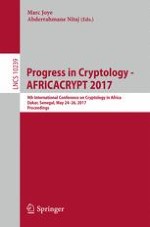2017 | Buch
Progress in Cryptology - AFRICACRYPT 2017
9th International Conference on Cryptology in Africa, Dakar, Senegal, May 24-26, 2017, Proceedings
herausgegeben von: Marc Joye, Abderrahmane Nitaj
Verlag: Springer International Publishing
Buchreihe : Lecture Notes in Computer Science
